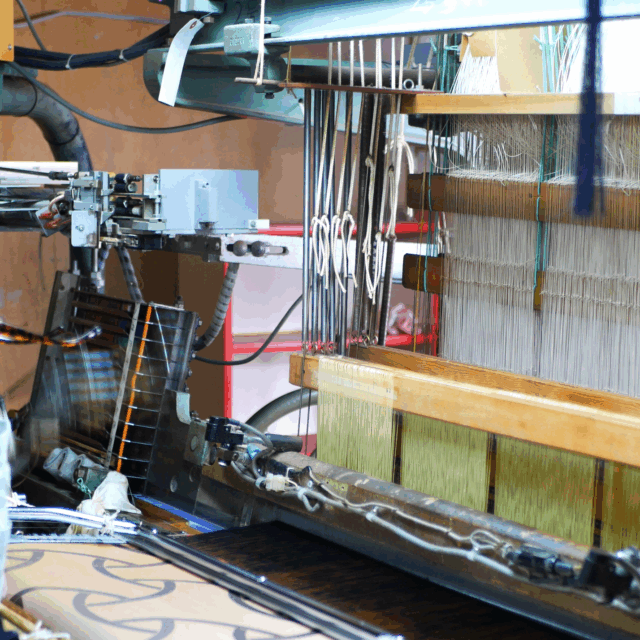
Nurtured by the Sound of Weaving|Okamoto Orimono’s Cooperative Workshop in Kyōtango – Nunohira

ZOZO Group’s media outlet FashionTechNews has featured our company in its new project ‘Artisan,’ which aims to build a bridge from the past to the future through Japanese craftsmanship.
‘Artisan’ delves into the depth of traditional crafts passed down across Japan, introducing the techniques, passion, and inspiring stories behind the artisans. This new project, which weaves together the past and the future, is a challenge to expand the possibilities of craftsmanship.
Our company manufactures and sells ‘Nishijin-ori.’ Nishijin is a town where artisans with specialised skills live and work together in a division of labour system, collaborating to weave a single piece of fabric. Currently, due to the stagnation of traditional Japanese clothing culture and the rise of fast fashion, sales in Nishijin have declined, and the number of artisans working in the upstream stages of production has been decreasing.
We have consistently expressed deep concern over this situation and have taken action to address it. This time, we had the opportunity to share our insights on the challenges faced by the manufacturing industry with the editorial team.
FashionTechNews ‘Artisan’ article here
Thank you very much to everyone at FashionTechNews for your thorough coverage.
In Nishijin, change is underway because something must be done.
We purchase thread in Nishijin, dye it, and with the help of various skilled craftsmen in Nishijin, we weave a single piece of Nishijin-ori gold brocade fabric. The repair of tools and machinery is also carried out by craftsmen living in Nishijin. However, the ageing of the craftsmen is becoming an urgent issue.
As craftsmen upstream age and their numbers decrease, the actual weavers are forced to stop weaving and instead repair the various machines and tools necessary for weaving.
Our company president, who is a traditional craftsman specialising in hand weaving, has become skilled at repairs without even realising it. A group called the ‘Assistance Team’ has been formed by those actually weaving Nishijin-ori gold brocade in Nishijin. Team members perform repairs and provide technical guidance, helping to preserve Nishijin’s traditional techniques while strengthening horizontal connections and assisting companies that cannot perform repairs in-house. This initiative was featured in the Asahi Shimbun Online on 10 April 2025.
2025年4月10日 10時15分 八百板一平記者 朝日新聞記事抜粋 https://www.asahi.com/articles/AST493SY2T49PLZB00FM.html
西陣織の織り手が、力をあわせて織機のトラブルなどに対応する「西陣お助け隊」を結成した。職人の高齢化や人材不足を職人同士の横のつながりでカバーするのが狙い。織り手の技術の向上や技の伝承にも取り組む。
「お助け隊」のメンバーは、西陣織工業組合(京都市上京区)に加盟する会社の有志13人。いずれも経験豊富な織り手で、織機のトラブルへの対応や修理、保守のためのノウハウを持っているという。
隊員は、組合に入っている会社などの求めに応じて、有料で織物づくりの現場に出向く。織機のトラブルへの対応や簡単な修理をし、金属製の部品のつけはずしなどの力仕事も担う。若手の職人を対象に織機の使い方の指導もするという。
着物の需要減による生産量の減少で、西陣織に関わる職人が減っている。特に織機の修理などを担う人材の不足は深刻だ。組合によると、織機の部品の販売やメンテナンスなどを手がける「機料店」は、高齢化で廃業が相次いでいる。かつては西陣地域に10軒以上あったが、現在、営業しているのは3軒ほど。一方で、織機は長年使い込んだものが多く、トラブルへの対応や修理のニーズが高まっているという。
お助け隊の隊長を務める村井昌則さん(54)は「技術や図案の流出を防ぐため、織物をつくる場に、よその人を入れたくないという声もあるが、もうそんなことを言っていられる状況ではない。一丸となって、それぞれの経験を生かし、助けあうための窓口ができれば」と話す。
お助け隊は、発足初日の3月26日に西陣織会館(京都市上京区)で、力織機(りきしょっき)を使った研修会を開いた。
隊のメンバーが講師を務め、若手の織り手に、織機の使い方などを教えた。織り手として5年の経験がある小林勧奈さんは「情報を交換し、互いを補いあう場があってうれしい。技術の向上につなげたい」と話した。
組合は今後もお助け隊のメンバーを募って、活動の幅を広げていくという。
◇
西陣地域では、横のつながりを生かして苦境の打開をめざす取り組みが続いている。
西陣織の伝統工芸士の足立敏さん(65)は、自身を含むつづれ織りの織元4軒で、2024年2月に「つづれ織(おり)一の会」をつくった。
つづれ織りは、織り方の技法の一つ。なかでも、のこぎり状にした爪先で糸をかき寄せて織る「爪搔本綴織(つめかきほんつづれおり)」は、細やかな表現が特徴で、「爪で織る芸術品」とも呼ばれる。爪搔本綴織をはじめとする、つづれ織りの魅力に触れる人と機会を増やし、販路の拡大や担い手の育成、技の伝承につなげるのが、会の狙いだ。
足立さんのもとで腕を磨いた職人の中山みなもさん(29)も爪搔本綴織を手がける。「自分なりの表現を考えながらつくれるのが楽しい。自分が織ったものの先に、使ってくれる人がいると思うと、うれしい」
足立さんは「作り手が自らの手で魅力を発信し、届けていくことが大事。みんなで力をあわせることで、相乗効果がでてくれば」と話している。
To support these efforts, please visit the official website of the Nishijin Textile Industry Association.
Due to changes in modern lifestyles, opportunities to see traditional Japanese clothing in everyday life have decreased. In particular, interest in kimono is waning among the younger generation.
In particular, ‘Nishijin kimono’ is mainly formal wear, so there are few opportunities to wear kimono outside of formal occasions, and the culture of wearing kimono has gradually faded. Furthermore, the spread of fast fashion has accelerated this trend.

As a result of these factors, many traditional Japanese clothing stores have been forced to close, and the work of all craftsmen involved in the Japanese clothing industry has drastically decreased.
Our company specialises in weaving ceremonial Nishijin kinran brocade fabrics for shrines and temples using the Nishijin-ori technique. However, changes in religious beliefs have led to a decrease in participants in festivals and religious events, which in turn has affected the demand for fabrics used in shrines and temples, resulting in a decline in sales of existing fabrics.
It is understandable that ‘traditional Japanese attire’ and ‘ceremonial fabrics for shrines and temples’ may seem daunting to younger generations due to the effort required to purchase and wear them.
However, within the Nishijin-ori industry, efforts are being made to propose casual traditional Japanese attire and promote its appeal through social media, and signs of change are beginning to emerge. We are also actively sharing information, so we would be delighted if you could take a look.
The number of craftsmen in the upstream stages of Nishijin-ori’s specialised production system, who have played a crucial role in the industry, has been declining year by year. The aging of these craftsmen, who are responsible for thread production and dyeing—the foundation of Nishijin-ori gold kinran brocade textiles—and the lack of successors are becoming serious issues.
Why are the number of craftsmen decreasing? One factor is the decline in demand for Nishijin-ori kinran brocade fabrics, which has led to a reduction in work volume and fewer young people aspiring to become craftsmen. Additionally, the requirement for extensive experience and technical skills to become a craftsman, coupled with the current lack of sufficient income and stability, is also contributing to this trend.
As a result of the decline in the number of upstream artisans, the supply of necessary materials and tools has been delayed, forcing weavers to repair or procure them on their own. This has led to a overall decline in production efficiency.
The Nishijin textile industry as a whole has begun efforts to nurture young craftsmen and pass on techniques to the next generation. For example, technical training courses for young people are being held, initiatives to improve the working environment for craftsmen are underway, and the ‘rescue team’ mentioned above has also been launched.
As someone who works in Nishijin, I am very happy that you are interested in Nishijin weaving.

